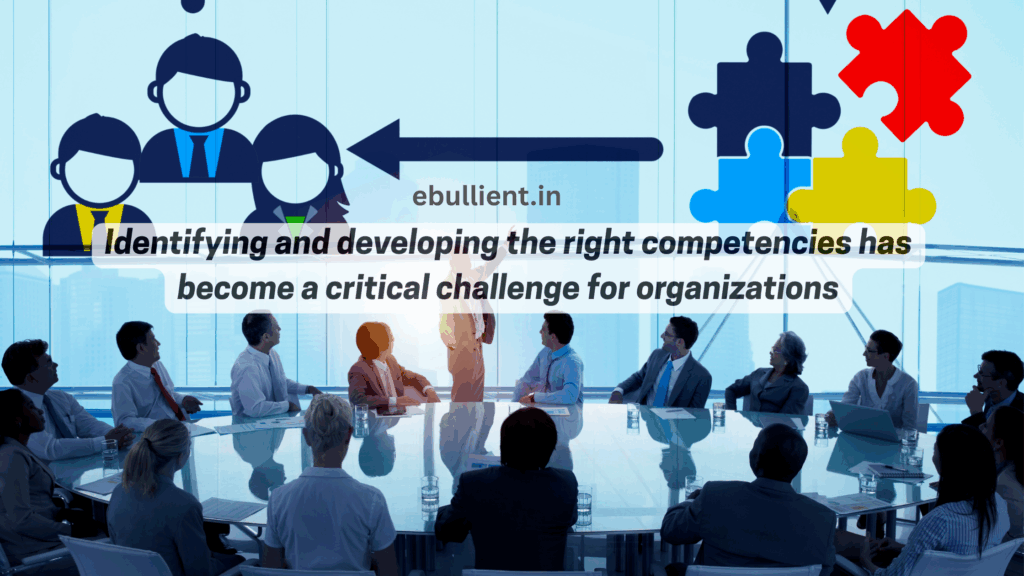As the competition becomes more intense, unlocking the potential of individuals with structured or intentional competency can no longer be ignored as a business necessity. According to a 2024 SHRM study, organizations that have competencies articulated are roughly 50% more likely to achieve strategic goals than organizations that do not have that clear competency structure. In short, the distinction between organizations that excel and organizations that follow competitors is often related to how well they structure and develop workforce capabilities via competency structures.
Introduction to competency framework development
Defining a competency framework
A competency framework is a structured framework that outlines the distinct skills, knowledge, behaviours and mindsets necessary for people to be effective in their roles. Unlike a simple job description, a competency framework is more akin to a working document, connecting one’s day-to-day performance with greater organisational outcomes. It outlines a description of what success looks like at various levels and in various roles, creating a common language for performance across the organisation.
In other words, when someone asks “what is a competency framework” you can distil it into a systematic way of naming and outlining the combinations of capabilities that produce superior results in a role.
Importance of competency frameworks in organizations
In the current economy, which focuses on talent as the priority, competency frameworks are critical to aligning workforce capability and strategy. Competency frameworks create clarity around what is expected from employees, provide clear pathways for employees to develop, and prioritize L&D within an organization for maximum impact.
Competency frameworks create structure and consistency across recruitment, performance management, L&D and succession planning and can transform HR activities from separate processes to an integrated capability engine. Data from Gartner shows, for example, that organizations investing in competency development demonstrate materially better revenue growth as against their peers – illustrating the business value of a competency framework.
Understanding the impact on individual and business outcomes
On an individual level, frameworks provide transparency: employees know exactly what behaviours and skills they need to develop to move forward. In that clarity, there is less ambiguity, increased engagement, and increased ownership of their development.
For organisations, the value is real. Companies who deploy competency frameworks typically experience lower turnover, more targeted training spend, and stronger talent pipelines, and become more fluid when priorities change. For example, Deloitte reported meaningful reductions in turnover after they had developed competency-based programs. When competencies inform the hiring, development and promotion processes, firms build a stronger bench and more predictable outcomes
EXPERT INSIGHT:
“Competency frameworks create the connective tissue between individual capability and organisational results. Designed well, they translate strategic aims into observable behaviours that can be developed, measured and rewarded.”
Key components of a competency framework
A practical competency framework combines several interlocking parts that together guide workforce development and decision-making.
Skills and competencies
While skills and competencies are frequently treated as the same, they can be perceived at different levels. Skills are specific to the a vocation that are oriented towards task performance, financial modelling or programming. Competencies involve the application of skills in a wider blend of knowledge, attitude and behaviours that make success repeatable.
For example, the competency of “project management” requires scheduling and budgeting skills, in addition to the ability to manage stakeholder communications and appraise risk while being disciplined in processes adapted to the particular project type. Competencies are supported by strong frameworks demonstrating both the trivial skills and the wider competency clusters that frame sustainable performance.
Core and functional competencies
Core competencies are the organisation-wide behaviours and values expected to be demonstrated by all—aspects like customer orientation, integrity, teamwork or innovation. They reflect the culture of the organisation and provide minimum performance standards or expectations for all employees.
Functional competencies refer to the specific skill sets that are required for specific job families or departments—e.g., clinical assessments for the healthcare job family or supply-chain analytics for a logistics team. The distinction between core and functional competencies ensures that the organisation maintains a cohesive culture, while excelling in employee behaviour that is job, firm and department specific.
Example — NHS core and functional competencies
The UK’s NHS employed a tiered approach in starting with organisational-wide core behaviours (patient-centred care, professionalism) plus job-specific clinical competencies or technical competencies with levels of proficiency associated with each. This has led to improved levels of care for patients and clearly defined levels of competence for professional development.
Behavioral competencies refer to the way in which work is accomplished – interpersonal skills and emotional intelligence, adaptable behavior, and conflict management – as opposed to just the outcome of the work completed. These competencies affect how effectively people work together and interact with each other regardless of the situation. Leadership competencies relate to the types of abilities needed to support and guide others (i.e. strategic thinking, decision-making, coaching and influencing others). Most large organisations (e.g. IBM) organize their leadership model into domains – strategy, client focus, collaboration, and results – and measure proficiency levels based on seniority level to better fund their leadership pipeline
Meta competencies and their role in growth
Meta competencies are higher-order capacities—learning agility, critical thinking, self-awareness and adaptability—that enable people to acquire and apply other competencies faster. In volatile markets, meta competencies often determine long-term career resilience because they let individuals pivot, learn and grow as job requirements evolve.
Forward-looking frameworks elevate meta competencies because they act as multipliers: developing them makes it easier to close skill gaps across a wide range of roles
The strategic importance of competency frameworks
Aligning competency frameworks with business goals
The most valuable frameworks translate strategic objectives into observable, developable behaviours. When organisations anchor competencies to priorities like customer centricity or innovation, development programs become directly relevant to business outcomes. SHRM’s research underscores this: clearly defined competencies materially increase the likelihood of hitting strategic targets.
This alignment prevents the familiar mismatch where HR activities are disconnected from the organisation’s strategic needs, ensuring learning programs and talent decisions drive measurable results.
Enhancing talent management and employee development
Competency frameworks create a common language for talent conversations across the employee lifecycle. They make hiring more objective—by defining the success criteria for roles—and enable targeted development programs that focus on capability-building rather than generic training.
Recent studies report sizeable improvements in performance and engagement where competencies are used consistently. For example, a major airline integrated competencies into onboarding and performance processes and achieved notable gains in customer satisfaction, turnover reduction and internal promotion rates.
Improving performance and career advancement opportunities
For employees, competencies demystify advancement: they clarify what observable behaviours and achievements lead to promotion. That makes career conversations more concrete and actionable, helping employees and managers co-create development plans tied to real outcomes.
For organisations, competency-based talent management improves internal mobility and identifies high-potential talent more accurately by focusing on the traits that predict success in future roles.
Streamlining human resource activities
When competencies are used across hiring, performance reviews, L&D and succession planning, HR functions become more efficient and coherent. A single competency model reduces the need for multiple, conflicting criteria and simplifies decision-making—improving speed and quality of hires and reducing administrative overhead.
Steps to develop an effective competency framework
A systematic approach improves the chance that a competency framework will be practical, used and sustainable. The seven steps below form a proven roadmap
Set up the project and define objectives
Establish a multidisciplinary team (HR, business leaders, SMEs). Establish project scope, define measures of success and develop a means of governance. Executive sponsorship is essential to resource the work and drive uptake.
Collect data and stakeholder input
Review strategic plans, job descriptions, and performance data. Conduct interviews with top performers, hold focus groups, and deploy surveys. Use industry models to benchmark and ensure relevance.
Develop the competency framework
Decide on competency categories; define proficiency levels with behavioural indicators; create short but behaviourally descriptive statements; and use consistent terminology to enable usability across the organisation.
Example competency profile: Customer Service Representative
Customer focus: responds in real-time → anticipates needs → builds in processes to improve experience
Problem-solving: applies standard fix → analyses multi-faceted problems → takes steps to avoid recurrence
Communication: messages are clear → adapts to audience → influences key stakeholders
Validation and iteration
Test the framework, gather SMEs feedback, link competencies back to performance measures, and refine. Iteration increases accuracy and employee acceptance.
Communications and implementation
Plan for rollout including manager training; employee-facing materials; and integration support. An effective rollout devotes substantial resources to change management to increase probability of adoption.
Integration with HR systems and processes
Embed competencies into job ads, interview guides, appraisal forms, learning pathways and succession tools. Use digital platforms to automate mapping, assessment and development planning.
Regular reviews and updates
Treat the framework as a living tool. Schedule annual or biennial reviews to add emerging skills, retire obsolete items and keep alignment with strategy.
Competency framework toolkit: Practical resources
Assessment tools and methods
- Self-assessment questionnaire: employees rate proficiency against behavioural indicators to identify development needs.
- 360-degree feedback template: collect concrete examples of competency demonstration from peers, managers and direct reports.
- Behavioral interview guide: craft level-appropriate questions (e.g., “Describe a time you implemented an innovative idea” → “How did you scale innovation across your team?”).
Development planning resources
- Competency development plan template: goal, actions, resources, timeline and success measures for each competency gap.
- Learning resource map: link courses, books, mentors and projects to competencies and proficiency levels.
Implementation support materials
- Manager’s implementation guide: practical steps for using competencies in hiring, performance talks, and development planning.
- Communication templates: executive announcement, department rollout note, and employee FAQ.
Best practices and real-world success stories
Organisations that succeed avoid common pitfalls—excessive complexity, vague definitions, or treating competencies as paper exercises. They engage stakeholders early, connect frameworks to real business problems, and provide managers with the tools to apply competencies day-to-day.
Examples: IBM, NHS and Southwest Airlines have all tied competency frameworks to measurable outcomes—leadership readiness, better patient care, and higher customer satisfaction—by integrating frameworks into talent processes and communications
Overcoming common pitfalls and resistance
Common failures come from designing frameworks in isolation, making them too complex, or lacking manager training. Successful programmes emphasise clear communication, executive backing, manager enablement, and quick pilots that show practical benefits.
EXPERT INSIGHT: “The real error isn’t in the design — it’s in treating competency frameworks as HR paperwork rather than strategic tools that drive everyday behaviour.”
Conclusion and next steps
Recap of key points
Competency frameworks are foundational to linking individual performance with organisational goals. They should align with strategy, distinguish core/functional/meta competencies, balance depth with usability, follow a structured build process, integrate with HR systems, and be regularly refreshed.
Future trends in competency frameworks
Expect frameworks to become more digitally integrated, support T-shaped capability development, emphasise adaptability and learning agility, and leverage AI tools for skills intelligence and personalised development.
Self-assessment: Is your organization prepared?
Use a brief readiness assessment to examine the clarity of the strategy, quality of role clarity, senior leadership support, HR role in competency management, and degree of competency data availability. If there are gaps, identify a limited pilot scope to demonstrate promise.
Next steps: What you do next
Form a cross-functional working group, select a priority business challenge, audit existing job-related data, assess available digital tools, and co-create a pilot approach for one job family. Important to remember: frameworks develop through use and iterative processes – not because they are perfect in the beginning!
In summary, by viewing competency frameworks as elements of strategic capability vs. a static HR document, organizations develop a strong lever for growth—-serving a workforce that meets the demands of the day and learns from opportunities for the future.



